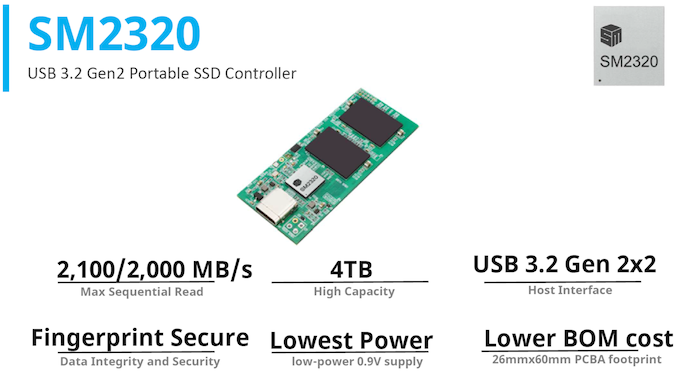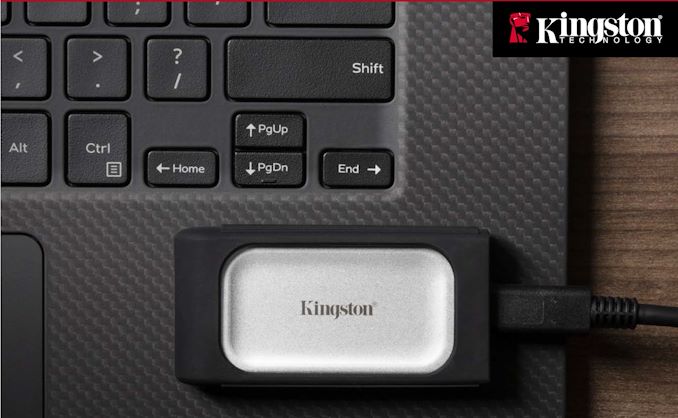USB 3.2 Gen 2x2 Portable SSDs Go Native: The Silicon Motion SM2320 UFD Controller Preview
by Ganesh T S on September 16, 2021 8:00 AM EST- Posted in
- Storage
- SSDs
- Kingston
- DAS
- Silicon Motion
- External SSDs
- USB 3.2 Gen 2x2
Miscellaneous Aspects and Concluding Remarks
The performance of the storage bridges / drives in various real-world access traces as well as synthetic workloads was brought out in the preceding sections. We also looked at the performance consistency for these cases. Power users may also be interested in performance consistency under worst-case conditions, as well as drive power consumption. The latter is also important when used with battery powered devices such as notebooks and smartphones. Pricing is also an important aspect. We analyze each of these in detail below.
Worst-Case Performance Consistency
Flash-based storage devices tend to slow down in unpredictable ways when subject to a large number of small-sized random writes. Many benchmarks use that scheme to pre-condition devices prior to the actual testing in order to get a worst-case representative number. Fortunately, such workloads are uncommon for direct-attached storage devices, where workloads are largely sequential in nature. Use of SLC caching as well as firmware caps to prevent overheating may cause drop in write speeds when a flash-based DAS device is subject to sustained sequential writes.
Our Sequential Writes Performance Consistency Test configures the device as a raw physical disk (after deleting configured volumes). A fio workload is set up to write sequential data to the raw drive with a block size of 128K and iodepth of 32 to cover 90% of the drive capacity. The internal temperature is recorded at either end of the workload, while the instantaneous write data rate and cumulative total write data amount are recorded at 1-second intervals.
| Sequential Writes to 90% Capacity - Performance Consistency | |
| TOP: | BOTTOM: |
 |
|
The SM2320 reference design is able to sustain 1600MBps+ writes for close to 65 seconds before dropping down to the 100MBps range. This points to a SLC cache of around 108GB - slightly more than 10% of the drive's capacity. Even after running out of the SLC cache, the drop in transfer rate allows the controller to regain some of the cache by moving data to the TLC segment while the direct-to-TLC writes are in progress. This enables the sudden regular spikes of the transfer rate to the 1GBps mark. The lack of any thermal solution (note that we are evaluating a bare PCB here) means that we can't make any comments on the recorded temperature.
Power Consumption
Bus-powered devices can configure themselves to operate within the power delivery constraints of the host port. While Thunderbolt ports are guaranteed to supply up to 15W for client devices, USB 2.0 ports are guaranteed to deliver only 2.5W (500mA @ 5V). In this context, it is interesting to have a fine-grained look at the power consumption profile of the various external drives. Using the Plugable USBC-TKEY, the bus power consumption of the drives was tracked while processing the CrystalDiskMark workloads (separated by 5s intervals). The graphs below plot the instantaneous bus power consumption against time, while singling out the maximum and minimum power consumption numbers.
| CrystalDiskMark Workloads - Power Consumption | |
| TOP: | BOTTOM: |
 |
|
The above graph backs up the power-efficiency claims of Silicon Motion with respect to the SM2320. A peak of 3.84W is much lower than the 5.88W peak obtained with the most power-efficient SK hynix P31 SSD behind the ASMedia ASM2364 bridge chip. The idle power (0.7W) matches the other native UFD solution in the Phison U17 (though that chip is a USB 3.2 Gen 2 solution, unlike the SM2320's Gen 2x2). However, this power number is higher than the best bridge solution's 0.49W. Otherwise, for long idle periods, the reference design will go to a completely idle state (sipping as low as 9mW) after around 20 minutes.
Final Words
Silicon Motion's SM2320 reference design allowed us to get an idea of the capabilities of high-performance native USB flash drive (UFD) controllers in a USB 3.2 Gen 2x2 configuration. The company also has a USB 3.2 Gen 2 solution in the SM2321, which will be looked at in a retail product shortly.
Performance-wise, the product ends up behaving similarly to a DRAM-less PCIe 3.0 x4 NVMe SSD behind a USB 3.2 Gen 2x2 bridge. The lack of DRAM for flash management may affect the performance for certain workloads, but that is more than made up for by the liberal amount of SLC cache – more than 10% of the drive's capacity. Write-intensive workloads with a larger active set can get negatively affected, but most consumers on the lookout for a UFD controller-based portable SSD are unlikely to put their drive through such access traces. Retail products based on the SM2320 are likely to be much smaller than dual-chip (bridge + controller) solutions.
The success of any product depends on the pricing. While we do not have any idea of what Silicon Motion charges its customers for the SM2320, we do have a product already in retail using the solution - the Kingston XS2000.
At $160, it undercuts the WD_BLACK P50 and Seagate FireCuda Gaming SSD by $50. Even a DIY solution with the SK hynix P31 and the SilverStone MS12 ends up at $185. While some of these costlier solutions offer better performance for some workloads, the XS2000 wins on the power efficiency front. Silicon Motion and Kingston seem to have the right pricing strategy to ensure that USB 3.2 Gen 2x2 continues to gain traction in the market.













18 Comments
View All Comments
Bik - Thursday, September 16, 2021 - link
these would be good to use in laptop with limited power budgetmeacupla - Thursday, September 16, 2021 - link
It would be nice to see an NVMe SSD that has even more power efficiency than a P31, for sure.Samus - Friday, September 17, 2021 - link
What I find amazing is how fast and power efficient this thing is for having a USB-C connector. Getting that performance out of that many conductors is just amazing.bernstein - Thursday, September 16, 2021 - link
IMHO (re)using (old) m2 nvme/sata ssd's in a external case (usb-bridge) is in almost all cases the cheaper/more flexible solution. sure it's a tiny bit bigger, more-expensive & less power-efficient... but for single external drive these are almost always negelgible.meacupla - Thursday, September 16, 2021 - link
IDK about that.This XS2000 only has 500GB, 1TB and 2TB models, and I would think most people will be upgrading TO that size, rather than upgrading FROM that size.
When you add in the cost of an USB 3.2 Gen 2x2 external case, things end up not being cheap.
I am looking at the prices from my local retailer, and the price for the 500GB and 1TB model XS2000 is, in fact, better than buying separately.
For the 2TB model, buying separately is cheaper.
For the 500GB and 1TB model, it's only cheaper if I opt for an NVMe enclosure that is not capable of USB3.2 Gen 2x2
Drkrieger01 - Thursday, September 16, 2021 - link
I imagine we'll start seeing the return of some decent ultra highs speed USB sticks with these controllers now availableWereweeb - Thursday, September 16, 2021 - link
"The lack of any thermal solution (note that we are evaluating a bare PCB here) means that we can't make any comments on the recorded temperature." It's worrying that they sent you a bare PCB, instead of the product that costumers will buy, when they know y'all are likely to do the most throughout analysis of the device.I'd imagine that it's hard to fuck up with such an elegant and simple design, but you never know - Kingston is the one who managed to innovate in the creation of LED-fried NAND.
DigitalFreak - Thursday, September 16, 2021 - link
Do laptops outside of TigerLake even have USB 3.2 2x2 support? Let alone desktops.timecop1818 - Friday, September 17, 2021 - link
I don't think even tiger lake has native USB 2x2 without adding a bridge chipDigitalFreak - Friday, September 17, 2021 - link
I was thinking Thunderbolt 4 / USB 4 is backwards compatible with 2x2.